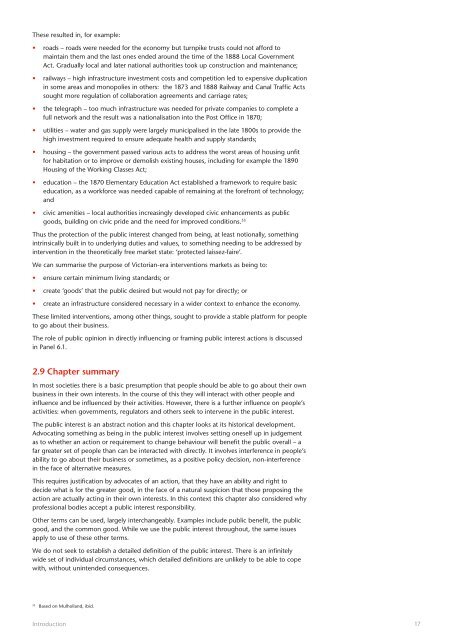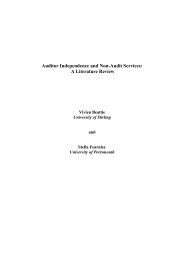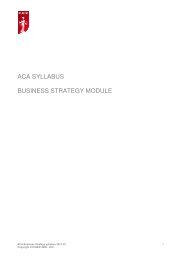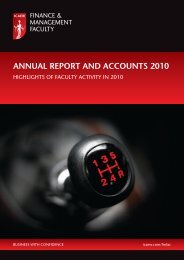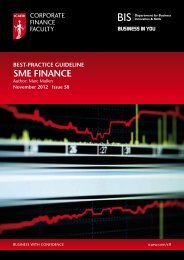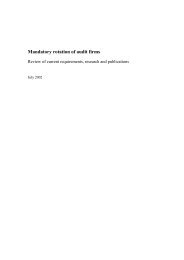The Mediterranean re<strong>public</strong>s needed a more complex notion of society and those whoadm<strong>in</strong>istered it. Plato, around two hundred years after Cyrus, argued that <strong>public</strong> officials shouldplace <strong>the</strong> <strong>in</strong>terests of society above <strong>the</strong>ir own 42 and Aristotle noted that society comprisedcommunities which come toge<strong>the</strong>r <strong>for</strong> <strong>the</strong> sake of some good: effectively <strong>the</strong> well-be<strong>in</strong>g of<strong>the</strong> citizens. 43 Cicero picked up on <strong>the</strong> stoic <strong>the</strong>sis of <strong>the</strong> common or shared good and moralconsensus. 44 The Romans even had a notion that <strong>the</strong> ‘populus’ could exist as a dist<strong>in</strong>ct legalentity able to make decisions with a s<strong>in</strong>gle voice. 45The later <strong>in</strong>fluences of Islam and Christianity added fur<strong>the</strong>r ideas of what outlook to take.There were potential conflicts between reason, based on human knowledge and logic, andreligious revelation, <strong>in</strong> which values were presented as a given. In <strong>the</strong> Islamic world <strong>the</strong> Ashariteview generally came to prevail, <strong>in</strong> which reason should be subord<strong>in</strong>ate to <strong>the</strong> Quran and <strong>the</strong>Sunna. 46 In Europe, Christian beliefs were comb<strong>in</strong>ed with those of Plato and Aristotle. Romanstoicism was moderated by Christian thought, August<strong>in</strong>e believ<strong>in</strong>g that <strong>the</strong> state should applymercy as a moral example. Aqu<strong>in</strong>as considered that laws should be: grounded <strong>in</strong> reason;<strong>in</strong>tended to foster <strong>the</strong> common good (‘bonum commune’); made by <strong>the</strong> whole people or <strong>the</strong>ir‘vice-regent’; and duly promulgated. Scholastics comb<strong>in</strong>ed reason and revelation, but arguedthat duties, pr<strong>in</strong>ciples and div<strong>in</strong>e order prevail over rights, obedience and political rule. 47Stability rema<strong>in</strong>ed a core aim. In Europe a mercantilist paternalism evolved which ensuredstability through giv<strong>in</strong>g certa<strong>in</strong> protections <strong>for</strong> <strong>the</strong> greater <strong>public</strong> through, <strong>for</strong> example,apprenticeships, sett<strong>in</strong>g of wage rates, control of prices and quality of staples, and use ofcommon lands. 48None of <strong>the</strong>se early philosophies are argu<strong>in</strong>g <strong>for</strong> <strong>in</strong>dividual rights: more a common good,determ<strong>in</strong>ed by leaders, albeit perhaps based on a generally accepted <strong>framework</strong>. Frederick <strong>the</strong>Great, ruler of Prussia from 1740 to 1786, set this out <strong>in</strong> a basic <strong>the</strong>ory of politics, <strong>in</strong>clud<strong>in</strong>g:‘The sovereign is <strong>the</strong> first servant of <strong>the</strong> state…one demands that he work efficiently <strong>for</strong> <strong>the</strong>good of <strong>the</strong> state…a pr<strong>in</strong>ce who governs personally…can guide all matters towards <strong>the</strong> endwhich he has set <strong>for</strong> himself.’ 49Society rema<strong>in</strong>ed relatively simple and rural well <strong>in</strong>to <strong>the</strong> n<strong>in</strong>eteenth century, even <strong>in</strong> <strong>the</strong>United K<strong>in</strong>gdom, so <strong>the</strong> paternalist model survived with it albeit, <strong>in</strong> England at least, that: <strong>the</strong>protestant re<strong>for</strong>mation and <strong>the</strong> English Commonwealth resulted <strong>in</strong> <strong>the</strong> <strong>in</strong>fluence of <strong>the</strong> stateeclips<strong>in</strong>g that of <strong>the</strong> church; and certa<strong>in</strong> accepted obligations such as <strong>the</strong> poor laws, weregradually replaced by specific legal requirements. 50The paternalist model gradually came under pressure from <strong>the</strong> ‘enlightenment’ and <strong>the</strong><strong>in</strong>dustrial revolution. The <strong>for</strong>mer was a late seventeenth and eighteenth century movement<strong>in</strong>volv<strong>in</strong>g th<strong>in</strong>k<strong>in</strong>g that, among o<strong>the</strong>r th<strong>in</strong>gs, promoted <strong>in</strong>dividual rights (eg, Grotius), <strong>in</strong>dividualmotivation (eg, Mandeville), scientific method (eg, Bacon) and rationalism (eg, Descartes).2.8.3 The Victorian eraThe <strong>in</strong>dustrial revolution <strong>in</strong> <strong>the</strong> United K<strong>in</strong>gdom resulted <strong>in</strong> significant changes from <strong>the</strong>perspective of act<strong>in</strong>g <strong>for</strong> <strong>the</strong> <strong>public</strong> good. Industrialisation created an <strong>in</strong>creased demand<strong>for</strong> capital and an urbanised work<strong>for</strong>ce. The <strong>for</strong>mer popularised jo<strong>in</strong>t stock companies withownership and management divorced. These were arguably <strong>the</strong> first large non-establishmentstructures and opened <strong>the</strong> way to a more pluralist society. 51 This and <strong>the</strong> move <strong>in</strong>to townsreplaced <strong>the</strong> land-based society with a more rootless one based on money, free of <strong>in</strong>gra<strong>in</strong>edduties. Mercantilism effectively gave way to capitalism, which drew on enlightenment notionsof <strong>in</strong>creased <strong>in</strong>dividualism and self-<strong>in</strong>terest and notions of progress and political representation.In essence, <strong>the</strong> <strong>in</strong>dustrial revolution saw ‘<strong>the</strong> substitution of competition <strong>for</strong> <strong>the</strong> medievalregulations which had previously controlled <strong>the</strong> production and distribution of wealth’. 52The result<strong>in</strong>g laissez-faire environment of Victorian Brita<strong>in</strong> could be argued to have doneaway with <strong>the</strong> notion of a <strong>public</strong> <strong>in</strong>terest, o<strong>the</strong>r than compliance with <strong>the</strong> rule of law.However, it became apparent that <strong>the</strong>re needed to be <strong>in</strong>terventions <strong>in</strong> markets.42Chapman and O’Toole, ‘The Role of <strong>the</strong> Civil Service: a traditional view <strong>in</strong> a period of change’.43Barnes, The Complete Works of Aristotle.44Rad<strong>for</strong>d, A Study <strong>in</strong> <strong>the</strong> Orig<strong>in</strong>s of Re<strong>public</strong>an Philosophy, discuss<strong>in</strong>g Cicero.45Sk<strong>in</strong>ner, The Foundations of Modern Political Thought: Volume 2: The Age of <strong>the</strong> Re<strong>for</strong>mation.46Aslan, No God but God.47Schall, At <strong>the</strong> Limits of Political Philosophy, Koetsier, Natural Law and Calv<strong>in</strong>ist Political Theory, Keys, Agu<strong>in</strong>as, Aristotle, and <strong>the</strong> Promiseof <strong>the</strong> Common Good.48Roberts, Paternalism <strong>in</strong> Early Victorian England, Mulholland, ‘21st Century Socialism: What <strong>the</strong> Victorians did <strong>for</strong> us’.49Quoted <strong>in</strong> Mosse, ‘Frederick II, Political Testament’.50Roberts, Paternalism <strong>in</strong> Early Victorian England.51Drucker, ‘The New Pluralism’.52Toynbee, quoted <strong>in</strong> Mulholland, ‘21st Century Socialism: What <strong>the</strong> Victorians did <strong>for</strong> us’.16Introduction
These resulted <strong>in</strong>, <strong>for</strong> example:• roads – roads were needed <strong>for</strong> <strong>the</strong> economy but turnpike trusts could not af<strong>for</strong>d toma<strong>in</strong>ta<strong>in</strong> <strong>the</strong>m and <strong>the</strong> last ones ended around <strong>the</strong> time of <strong>the</strong> 1888 Local GovernmentAct. Gradually local and later national authorities took up construction and ma<strong>in</strong>tenance;• railways – high <strong>in</strong>frastructure <strong>in</strong>vestment costs and competition led to expensive duplication<strong>in</strong> some areas and monopolies <strong>in</strong> o<strong>the</strong>rs: <strong>the</strong> 1873 and 1888 Railway and Canal Traffic Actssought more regulation of collaboration agreements and carriage rates;• <strong>the</strong> telegraph – too much <strong>in</strong>frastructure was needed <strong>for</strong> private companies to complete afull network and <strong>the</strong> result was a nationalisation <strong>in</strong>to <strong>the</strong> Post Office <strong>in</strong> 1870;• utilities – water and gas supply were largely municipalised <strong>in</strong> <strong>the</strong> late 1800s to provide <strong>the</strong>high <strong>in</strong>vestment required to ensure adequate health and supply standards;• hous<strong>in</strong>g – <strong>the</strong> government passed various acts to address <strong>the</strong> worst areas of hous<strong>in</strong>g unfit<strong>for</strong> habitation or to improve or demolish exist<strong>in</strong>g houses, <strong>in</strong>clud<strong>in</strong>g <strong>for</strong> example <strong>the</strong> 1890Hous<strong>in</strong>g of <strong>the</strong> Work<strong>in</strong>g Classes Act;• education – <strong>the</strong> 1870 Elementary Education Act established a <strong>framework</strong> to require basiceducation, as a work<strong>for</strong>ce was needed capable of rema<strong>in</strong><strong>in</strong>g at <strong>the</strong> <strong>for</strong>efront of technology;and• civic amenities – local authorities <strong>in</strong>creas<strong>in</strong>gly developed civic enhancements as <strong>public</strong>goods, build<strong>in</strong>g on civic pride and <strong>the</strong> need <strong>for</strong> improved conditions. 53Thus <strong>the</strong> protection of <strong>the</strong> <strong>public</strong> <strong>in</strong>terest changed from be<strong>in</strong>g, at least notionally, someth<strong>in</strong>g<strong>in</strong>tr<strong>in</strong>sically built <strong>in</strong> to underly<strong>in</strong>g duties and values, to someth<strong>in</strong>g need<strong>in</strong>g to be addressed by<strong>in</strong>tervention <strong>in</strong> <strong>the</strong> <strong>the</strong>oretically free market state: ‘protected laissez-faire’.We can summarise <strong>the</strong> purpose of Victorian-era <strong>in</strong>terventions markets as be<strong>in</strong>g to:• ensure certa<strong>in</strong> m<strong>in</strong>imum liv<strong>in</strong>g standards; or• create ‘goods’ that <strong>the</strong> <strong>public</strong> desired but would not pay <strong>for</strong> directly; or• create an <strong>in</strong>frastructure considered necessary <strong>in</strong> a wider context to enhance <strong>the</strong> economy.These limited <strong>in</strong>terventions, among o<strong>the</strong>r th<strong>in</strong>gs, sought to provide a stable plat<strong>for</strong>m <strong>for</strong> peopleto go about <strong>the</strong>ir bus<strong>in</strong>ess.The role of <strong>public</strong> op<strong>in</strong>ion <strong>in</strong> directly <strong>in</strong>fluenc<strong>in</strong>g or fram<strong>in</strong>g <strong>public</strong> <strong>in</strong>terest actions is discussed<strong>in</strong> Panel 6.1.2.9 Chapter summaryIn most societies <strong>the</strong>re is a basic presumption that people should be able to go about <strong>the</strong>ir ownbus<strong>in</strong>ess <strong>in</strong> <strong>the</strong>ir own <strong>in</strong>terests. In <strong>the</strong> course of this <strong>the</strong>y will <strong>in</strong>teract with o<strong>the</strong>r people and<strong>in</strong>fluence and be <strong>in</strong>fluenced by <strong>the</strong>ir activities. However, <strong>the</strong>re is a fur<strong>the</strong>r <strong>in</strong>fluence on people’sactivities: when governments, regulators and o<strong>the</strong>rs seek to <strong>in</strong>tervene <strong>in</strong> <strong>the</strong> <strong>public</strong> <strong>in</strong>terest.The <strong>public</strong> <strong>in</strong>terest is an abstract notion and this chapter looks at its historical development.Advocat<strong>in</strong>g someth<strong>in</strong>g as be<strong>in</strong>g <strong>in</strong> <strong>the</strong> <strong>public</strong> <strong>in</strong>terest <strong>in</strong>volves sett<strong>in</strong>g oneself up <strong>in</strong> judgementas to whe<strong>the</strong>r an action or requirement to change behaviour will benefit <strong>the</strong> <strong>public</strong> overall – afar greater set of people than can be <strong>in</strong>teracted with directly. It <strong>in</strong>volves <strong>in</strong>terference <strong>in</strong> people’sability to go about <strong>the</strong>ir bus<strong>in</strong>ess or sometimes, as a positive policy decision, non-<strong>in</strong>terference<strong>in</strong> <strong>the</strong> face of alternative measures.This requires justification by advocates of an action, that <strong>the</strong>y have an ability and right todecide what is <strong>for</strong> <strong>the</strong> greater good, <strong>in</strong> <strong>the</strong> face of a natural suspicion that those propos<strong>in</strong>g <strong>the</strong>action are actually act<strong>in</strong>g <strong>in</strong> <strong>the</strong>ir own <strong>in</strong>terests. In this context this chapter also considered whyprofessional bodies accept a <strong>public</strong> <strong>in</strong>terest responsibility.O<strong>the</strong>r terms can be used, largely <strong>in</strong>terchangeably. Examples <strong>in</strong>clude <strong>public</strong> benefit, <strong>the</strong> <strong>public</strong>good, and <strong>the</strong> common good. While we use <strong>the</strong> <strong>public</strong> <strong>in</strong>terest throughout, <strong>the</strong> same issuesapply to use of <strong>the</strong>se o<strong>the</strong>r terms.We do not seek to establish a detailed def<strong>in</strong>ition of <strong>the</strong> <strong>public</strong> <strong>in</strong>terest. There is an <strong>in</strong>f<strong>in</strong>itelywide set of <strong>in</strong>dividual circumstances, which detailed def<strong>in</strong>itions are unlikely to be able to copewith, without un<strong>in</strong>tended consequences.53Based on Mulholland, ibid.Introduction17
- Page 1 and 2: ACTING IN THE PUBLIC INTEREST:A FRA
- Page 3: ACTING IN THE PUBLIC INTEREST:A FRA
- Page 9: Our framework is based around the k
- Page 12 and 13: The answers to these questions will
- Page 14 and 15: 2. INTRODUCTION2.1 Concepts of the
- Page 16 and 17: Accordingly, this report addresses
- Page 18 and 19: Panel 2.4: ICAEW and its public int
- Page 22 and 23: We set out a framework for discussi
- Page 24 and 25: 3. CREDENTIALS FOR INVOKINGTHE PUBL
- Page 26 and 27: By and large producers operate in s
- Page 29 and 30: the UK government set up a ‘Commi
- Page 31 and 32: 4. APPLICABILITY OF THE PUBLIC INTE
- Page 33 and 34: to be a public interest matter: fir
- Page 35: This highlights that there may be p
- Page 38 and 39: 5. THE RELEVANT PUBLIC5.1 ScopeIn o
- Page 40 and 41: 5.3 Geographical exclusionsGeograph
- Page 42 and 43: 6. THE RELEVANT PUBLIC’S WANTS6.1
- Page 44 and 45: • work, that is having some, havi
- Page 46 and 47: Panel 6.3: Weisbrod’s public inte
- Page 48 and 49: Having sought out representative op
- Page 50 and 51: 7. CONSTRAINTS TO WANTS7.1 Self-int
- Page 52 and 53: In terms of whether the relevant pu
- Page 54 and 55: Panel 7.5: Management of national d
- Page 56 and 57: Panel 7.6: ICAEW and clarity of val
- Page 58 and 59: 8. AGGREGATION AND DECISION8.1 Base
- Page 60 and 61: Other ethical decision-making model
- Page 62 and 63: In this instance, while national se
- Page 65 and 66: 9. IMPLEMENTATIONA proposed action
- Page 67 and 68: • giving up where targets seem un
- Page 69 and 70: 9.2.1 Government authorityAt the st
- Page 71 and 72:
9.3 Infrastructure and support tool
- Page 73 and 74:
12. The framework proposes a signif
- Page 75 and 76:
ibliographyAdler, Jonathan H, Perve
- Page 77 and 78:
Goldstein, Eric A, ‘Defining the
- Page 79 and 80:
Persky, Joseph, ‘Retrospectives:
- Page 81:
The ICAEW is a founder member of th


